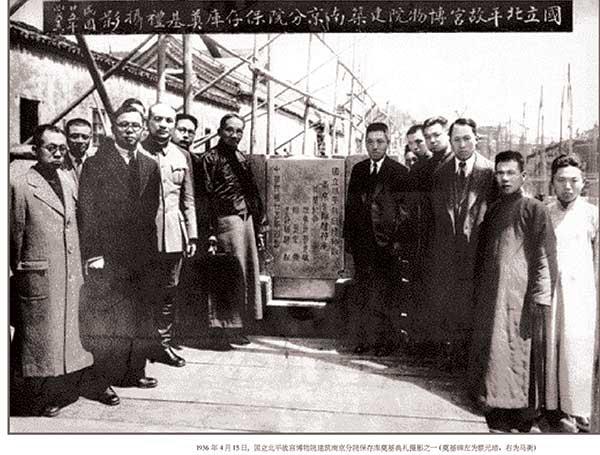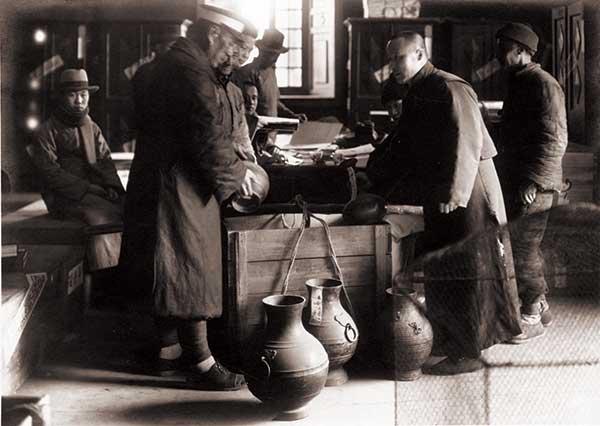n June 1987, archaeologist Zhang Zhongpei became the director of the Palace Museum, the former Forbidden City that once housed China’s emperors. His main ambition he expected to fulfill during his term was to retrieve all the cultural relics that had been sent to other parts of China during the periods of political turmoil from the mid-1930s to the mid-1970s.
After the initial incursions in 1931 that would lead to the Second Sino-Japanese War, over a million pieces of cultural relics belonging to the Palace Museum were secretly transported from Beiping (then the name for Beijing, when it was not the capital, “jing” means “capital”) to southern China for safekeeping. After defeating Japan, China was immediately plunged into civil war. Some of the treasures were taken to Taiwan by the Kuomintang government following the civil war, and are now kept at the National Palace Museum in Taiwan. Of those remaining on the Chinese mainland, most were taken back to the Palace Museum in Beijing. While another significant portion of relics, a total of 2,211 boxes containing china, statues, and paintings were not returned to Beijing, but have been kept in Nanjing until the present.
Zhang Zhongpei, the former director of the Palace Museum, talked to NewsChina about the division of the collection between Beijing and Nanjing in an interview in November: “To bring back all the cultural relics to Beijing would indeed be meaningful for the country’s unification process. If we cannot even solve the historical remaining issues in the Chinese mainland, how could we possibly ask the National Palace Museum [in Taiwan] to return theirs to us? Thus I decided to try having those artifacts in Nanjing taken back before fulfilling the more difficult mission in retrieving a complete collection for the Summer Palace.”
Incredible Journey
In order to save one of the world’s greatest collections from the invading Japanese army, the Palace Museum management made the decision to relocate selected pieces to safe places – temporarily.
On the night of February 5, 1933, the whole city of Beiping was cordoned off as dozens of wooden carts set off from the Forbidden City to the city’s main train station. Soldiers stood guard along the silent roads that made up the route.
On the carts, there were a total of 13,427 carefully wrapped boxes and 64 packages of cultural relics.
By 1936, the whole contingent had eventually been sent to Nanjing and stored in the Chaotiangong warehouse. The Palace Museum also set up its Nanjing branch institute to administer the safekeeping of the treasure. With the chaos brought about by the war, over the following years, these items were sent in batches to different places across the country by train, cart, boat and car, including Huayan Cave in Guizhou, Emei and Leshan mountains in Sichuan, as well as Chongqing at different points, which was the Republican’s provisional capital during the conflict. In 1947, the items were finally sent back to Chaotiangong storehouse in Nanjing, a concrete three-story building along a basement, with an iron gate and small windows.
At the end of 1948, the Kuomintang government, realizing its coming defeat to the Communists, started to send antiques from Nanjing to Taiwan. In three separate shipments, a total of 2,972 boxes of the items, accounting for over one fourth of everything being stored in Nanjing were transferred.
Traveling together with the consignments were 15 employees from the Nanjing branch institute, none of whom ever returned to the Chinese mainland. Soon after the founding of the People’s Republic of China in October 1949, spy planes dispatched by the Taiwanese government would circle over Nanjing, Liang Jinsheng, the present director of the Cultural Relics Management Department at the Palace Museum, told NewsChina. Liang was just a toddler at the time. His parents were both staff employees at the Palace Museum’s Nanjing branch institute, and according to Liang, every time an airplane did a sweep of the city, he would follow others and rush for shelter in the storehouse basement. The sight of the storehouse windows protected by anti-blast equipment is still embedded deep in Liang’s memory.
Soon after, in the 1950s, the majority of the items in storage were transported back to Beijing in three separate consignments. According to the official records released by the Palace Museum, a total of 11,178 boxes of artifacts were sent to Nanjing during the wartime. In 1950, 1,500 boxes were moved to Beijing, followed by 716 boxes in 1953 then 4,027 boxes in 1958, a total of 6,243.
However, there are differing accounts on the issue of numbers. For example Ma Heng, a former director of the Palace Museum (1933-1952), once said a total of 8,308 boxes of artifacts were moved back to Beijing. Despite numbers disparity, various sources agree that 2,211 boxes were left behind in Nanjing.
In 1960, the Palace Museum handed the property and management rights of its Nanjing branch to the local Jiangsu Provincial Department of Culture. The two museums agreed that “all 2,211 boxes of artifacts should be kept intact and remain at Chaotiangong storehouse. The Palace Museum is responsible for the registering and listing of the artifacts. The deposit time is temporary and should end no later than the end of 1961.”
However due to the domestic social instability that resulted from various political campaigns of the late 1950s and the breakout of the decade-long Cultural Revolution in 1966, the Palace Museum could not fulfill its promise to return the remaining artifacts in the promised time frame. The storage house was later appointed as a facility by Jiangsu Province to Nanjing Museum.

 Old Version
Old Version

